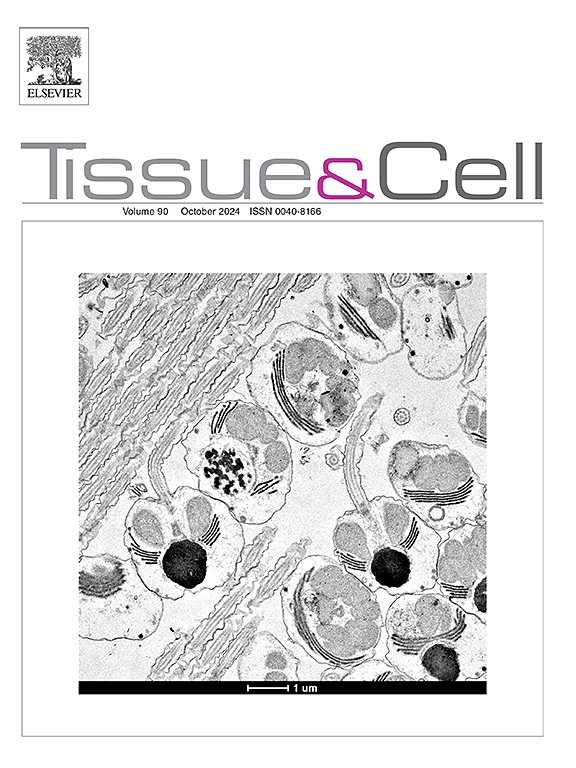基于蛋白激酶r样内质网激酶/真核细胞起始因子2α通路的蠲痛饮对子宫内膜异位症大鼠内质网应激自噬的影响机制
IF 2.5
4区 生物学
Q1 ANATOMY & MORPHOLOGY
引用次数: 0
摘要
目的通过蛋白激酶r样内质网激酶(PERK)/真核细胞起始因子2α (eIF2α)自噬通路,探讨蠲痛饮(JTY)对子宫内膜异位症(EM)大鼠内质网应激自噬的作用机制。方法建立EM大鼠模型。将70只SD大鼠随机分为正常对照组、模型组、JTY高、中、低剂量组(分别为25.4、12.7、6.35 g/kg)、黄体酮组(0.26 mg/kg)和ER应激组(2-DG, 100 mg/kg)。给药组灌胃相应剂量的药物,模型组和正常对照组灌胃生理盐水(1 mL/100 g)。连续用药4周。测量异位病变体积及盆腔粘连评分。采用苏木精-伊红(HE)染色观察大鼠异位内皮的病理变化。采用酶联免疫吸附法(ELISA)检测各组血清炎症标志物c反应蛋白(CRP)、雌二醇(E2)水平;采用免疫组织化学、实时荧光定量聚合酶链反应(real-time PCR)和蛋白质免疫印迹法(Western blotting)检测异位内皮细胞PERK、eIF2α、微管相关蛋白轻链3B (LC3B)和mRNA的表达。结果与模型组比较,jty组大鼠异位病变体积明显减小(P <; 0.05),盆腔粘连评分明显降低(P <; 0.05),异位内皮病理表现为不同程度的萎缩、脱离、腺体减少。血清炎症标志物CRP、E2水平显著降低,JTY可促进PERK、eIF2α、微管相关蛋白LC3B蛋白及mRNA的表达(P <; 0.05)。结论jty通过激活PERK/eIF2a通路,增强细胞内质网应激和自噬,改善炎症微环境,最终减轻大鼠EM。本文章由计算机程序翻译,如有差异,请以英文原文为准。
Mechanism of the effect of Juan-Tong-Yin on endoplasmic reticulum stress-autophagy in endometriosis rats based on protein kinase R-like endoplasmic reticulum kinase/eukaryotic cell initiation factor 2α pathway
Objective
To explore the mechanism of Juan-Tong-Yin (JTY) on endoplasmic reticulum (ER) stress-autophagy in endometriosis (EM) rats through the protein kinase R-like endoplasmic reticulum kinase (PERK)/eukaryotic cell initiation factor 2α (eIF2α) autophagy pathway.
Methods
An EM rat model was established. A total of 70 Sprague–Dawley (SD) rats were randomly divided into the normal control group, model group, JTY high-, medium- and low-dose groups (25.4, 12.7, and 6.35 g/kg, respectively), progesterone group (0.26 mg/kg), and ER stress group (2-DG, 100 mg/kg). The seven groups were given the corresponding dose of the drug through gavage in the administration group and saline through gavage (1 mL/100 g) in the model and normal control groups. The drugs were administered continuously for 4 weeks. Ectopic lesion volume and pelvic adhesion score were measured. Hematoxylin-eosin (HE) staining was used to observe the pathological changes of ectopic endothelium in rats. Enzyme-linked immunosorbent assay (ELISA) was used to detect the levels of serum inflammatory marker C-reactive protein (CRP) and estradiol (E2) in each group; immunohistochemistry, real-time fluorescence quantitative polymerase chain reaction (Real-time PCR), and protein immunoblotting method (Western blotting) were used to detect the expressions of ectopic endothelial PERK, eIF2α, and microtubule-associated protein light chain 3B (LC3B) and mRNA.
Results
Compared with the model group, the JTY-treated rats exhibited significantly reduced ectopic lesion volume (P < 0.05), the pelvic adhesion score was decreased (P < 0.05), and the pathology of the ectopic endothelium showed varying degrees of atrophy, detachment, and gland reduction. In addition, serum inflammatory marker CRP and E2 levels were decreased significantly, and JTY promoted the expression of PERK, eIF2α, and microtubule-associated protein LC3B protein and mRNA (P < 0.05).
Conclusion
JTY ameliorates EM by activating the PERK/eIF2a pathway, enhancing cell ER stress and autophagy, improving the inflammatory microenvironment, and ultimately mitigating EM in rats.
求助全文
通过发布文献求助,成功后即可免费获取论文全文。
去求助
来源期刊

Tissue & cell
医学-解剖学与形态学
CiteScore
3.90
自引率
0.00%
发文量
234
期刊介绍:
Tissue and Cell is devoted to original research on the organization of cells, subcellular and extracellular components at all levels, including the grouping and interrelations of cells in tissues and organs. The journal encourages submission of ultrastructural studies that provide novel insights into structure, function and physiology of cells and tissues, in health and disease. Bioengineering and stem cells studies focused on the description of morphological and/or histological data are also welcomed.
Studies investigating the effect of compounds and/or substances on structure of cells and tissues are generally outside the scope of this journal. For consideration, studies should contain a clear rationale on the use of (a) given substance(s), have a compelling morphological and structural focus and present novel incremental findings from previous literature.
 求助内容:
求助内容: 应助结果提醒方式:
应助结果提醒方式:


